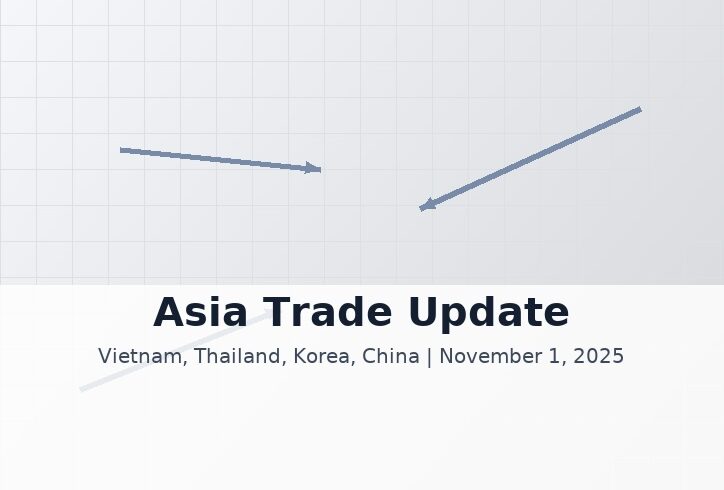
The short version
President Trump’s trip produced three practical outcomes for companies that buy or sell internationally.
First, the United States and Vietnam, and the United States and Thailand, announced trade deal frameworks that set baseline tariff rates and point to future carve outs. Second, the United States confirmed a 15 percent tariff level on many imports from South Korea, including autos and parts. Third, the United States announced a pause in how broadly some export control rules will apply, while China paused certain rare earth controls.
None of these announcements change the law at the border until U.S. government agencies publish formal notices. But they do change what you should plan for in pricing, sourcing, and inventory.
What is new since the trip
BIS “50 percent Affiliates Rule”: what it is and why the pause matters
Plain explanation. In U.S. export controls, some companies are restricted. The “50 percent Affiliates Rule” says that if a restricted company owns 50 percent or more of another company, that other company is treated as restricted too. Ownership can be direct or through multiple layers of companies. It can also be a combination of stakes that add up to 50 percent or more. In practice, you must check not just your counterparty but also who owns your counterparty. Companies owned by Chinese companies are particularly susceptible to this export control.
What Treasury announced. Treasury said the United States will pause the use of this rule for one year. This announcement came at the same time China said it would pause certain rare earth export limits for one year.
What is legally in force today. The pause is not legally effective until the Commerce Department’s Bureau of Industry and Security publishes a notice in the Federal Register. The Federal Register is the official daily record of U.S. government rules. Until that notice appears, act as if the rule is still in effect.
Political fragility note
This pause is a political understanding, not a permanent change. If China brings back rare earth limits, the United States may bring back broader use of the Affiliates Rule. Past U.S.–China frameworks have fallen apart quickly when either side believed the other was not following through. Plan on two sets of procedures. Use a tighter approach if the rule is on. Use a simpler approach if the rule is paused. Be ready to switch with little notice.
What to do this week
List your most important suppliers and customers in China and across Asia.
Identify who owns them, including owners through other entities, and add up ownership percentages to see who controls what.
Ask higher risk counterparties for updated ownership certificates.
Keep your current screening and licensing processes in place. Prepare a short internal note that explains how you will adjust if BIS publishes the pause.
China also said it will resume buying some U.S. farm products like soybeans. Treat this as a political signal for now since no volumes or dates are set.
Section 301 maritime investigation: reported one year pause, formal notice pending
Reports indicate the United States will pause by one year a trade action under Section 301 that targets China’s maritime, logistics, and shipbuilding sectors. Reports also say China will pause its responses. This is not yet a formal change. Until the U.S. Trade Representative publishes an official notice, treat this as guidance for planning, not a change in law.
What to do this week
Review your contracts with carriers and, if you use them, freight forwarders to confirm you can switch providers quickly if new tariffs or restrictions take effect. Check termination and change-of-service rights, notice periods, and any minimum volume or liquidated damages terms that could slow a switch. Map and price alternative routes and providers now. If you can book with carriers based outside China at comparable rates and service levels, prefer them for new bookings.
Vietnam and Thailand: frameworks are real, and baseline reciprocal tariffs are now clear
The United States released joint statements with Vietnam and with Thailand. These are frameworks, not final agreements. They set a general approach and say more details will come in annexes.
For Vietnam, the U.S. baseline tariff rate is 20 percent. Some products could later be listed in an annex for a zero percent rate.
For Thailand, the U.S. baseline tariff rate is 19 percent. Some products could later be listed in an annex for a zero percent rate.
Both frameworks mention working on non-tariff barriers. Examples include acceptance of U.S. vehicle standards and faster approvals for certain medical devices and pharmaceuticals.
There is no change at the border until the United States publishes final texts and annexes. For planning, assume the baseline holds unless your exact product shows up in a future annex.
What to do this week
Tag every Vietnam and Thailand product by its HS code. The HS code is the classification number customs uses to set tariff rates.
Build landed cost models using the 20 percent and 19 percent baselines.
Create a second version of the model that assumes a zero percent rate in case your HS code appears in a future annex.
Gather certificates and U.S. standards paperwork now so you are ready to move quickly if non-tariff barriers come down.
South Korea: the 15 percent tariff regime was reaffirmed and discussed around the October 29 Gyeongju meetings
The United States has confirmed a 15 percent tariff level for many imports from South Korea. At the October 29 meetings in Gyeongju, Korea, officials confirmed that the 15 percent rate applies to automobiles and auto parts, down from 25 percent, and outlined how implementation will proceed. This aligns South Korea with recent outcomes for Japan and the European Union. Plan on your South Korea products being tariffed at around 15 percent unless a new legal notice says otherwise.
China tariff relief tied to fentanyl: announced October 30, still not effective until USTR or CBP publishes
On October 30, after the meeting with President Xi in Busan, President Trump said the United States would reduce some fentanyl related tariff lines on Chinese goods from 20 percent to 10 percent. As of this morning, there is no U.S. Trade Representative or Customs and Border Protection notice that makes this change effective.
Continue to use the current tariff schedules. Make no pricing or booking decisions based only on the announcement, but since this seems to be what convinced China to back down on withholding its rare earths, the odds are good this will show up as official in short order.
What is unchanged, and still critical to your playbook
Annexes decide winners and losers
The joint statements with Vietnam and Thailand are roadmaps. They do not list specific HS codes, phase in schedules, safeguards, or quota rules. Those details will be in annexes and will decide which products benefit. Keep your models tied to the baseline rates and treat possible zero percent outcomes as upside until you see annex text.
Enforcement pressure is steady
U.S. enforcement is not easing. Customs will continue to test claims that processing in third countries creates a new origin. It will continue to look for transshipment through Southeast Asia and to question the use of the de minimis entry rule. Keep origin documentation that would hold up in a review after entry.
Uncertainty on retroactivity and refunds
If tariff rates later fall, refunds are not automatic. You must act within set time windows. Work with your broker and your international trade lawyers so you can file Post Summary Corrections before liquidation or Protests after liquidation. Keep a list of the affected entry numbers and dates so you can act on time.
Implementation track record creates execution risk
In 2025, many public announcements have been followed by delays or changes when the legal text arrived. Some measures have faced legal challenges or administrative rewrites. Expect the same risk here.
The Vietnam, Thailand, and China frameworks promise future work. They are not operative rules today. Budget time and resources for partial implementation, longer timelines, or changes between a press statement and the published rule.
The operating plan for November
Use the published baselines in your cost models. For China, model three paths: status quo, fentanyl only reduction, and broader reductions. Tie any price concessions or contract changes to the appearance of a Federal Register notice or an updated tariff schedule.
Finish your ownership mapping for the Affiliates Rule. Prepare a short internal memo that explains how procedures will change if BIS publishes the pause. Until then, continue screening and licensing as you do today.
For Vietnam and Thailand, prepare standards and regulatory documents so you can ship immediately if annexes give your products zero percent rates or faster approvals. Maintain a list of HS codes that are most likely to be carved out based on U.S. export priorities.
For South Korea, set 15 percent in budgets for 2026. Renegotiate pricing, Incoterms, and how you and your suppliers will share any duty changes.
Key takeaways
Legal and compliance anchor
The pause on the Affiliates Rule is a political announcement and will only be legally effective when BIS publishes a Federal Register notice.
The fentanyl related tariff cut has no legal effect until USTR or CBP publishes.
Tariff planning reality
Vietnam’s baseline is 20 percent and Thailand’s is 19 percent unless a later annex lists your HS code at zero percent.
South Korea’s 15 percent regime is the current planning anchor for autos and other covered goods.
Execution risk
All of the frameworks from the trip carry implementation risk. Keep sourcing flexible and documentation tight.
substantial transformation, first sale rule, de minimis entries, and China contract clauses that allocate tariff and export control risk.
For additional readings on U.S. tariff laws, check out the following:
THE Guide for LEGALLY Avoiding Today’s and Tomorrow’s U.S. Tariffs
U.S. Customs Compliance FAQ: Essential Answers Importers Need in 2025
Tariff Cheaters Beware: A $24 Million Reminder That YOUR Competitors Are Watching





